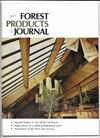南美白黄檀与其它三种相似黄檀鉴别特征成分的研究
IF 1.2
4区 农林科学
Q3 FORESTRY
引用次数: 1
摘要
根据前人的研究,利用红外光谱特征峰可以快速区分黄檀、黄檀和黄檀。为了研究红叶黄檀红外特征峰对应的成分,依次用石油醚、乙酸乙酯、丁醇提取红叶黄檀分散液。采用柱层析法对石油醚提取物进行进一步分离,利用傅里叶变换红外光谱(FTIR)对分离过程中的特征成分进行跟踪。石油醚萃取物的红外光谱分析表明,萃取物中存在芳香酮类和烯烃类化合物。气相色谱-质谱分析表明了其主要成分,并给出了可能的结构。此外,通过核磁共振方法对它们的详细结构进行了表征,并确定了两种可能的成分(3,5-二羟基-7-甲氧基-2-苯铬-4- 1和3,5,7-三羟基-2-苯铬-4- 1)。本文章由计算机程序翻译,如有差异,请以英文原文为准。
Study on the Characteristic Components of Distinguishing Dalbergia cochinchinensis from the Other Three Similar Dalbergia Species
Dalbergia cochinchinensis can be distinguished from Dalbergia retusa, Dalbergia bariensis, and Dalbergia oliveri quickly using infrared spectrum characteristic peaks as shown in a previous study. To investigate the components corresponding to the infrared characteristic peaks of Dalbergia cochinchinensis, petroleum ether, ethyl acetate, and butyl alcohol were sequentially used to extract the dispersion liquid of D. cochinchinensis. The petroleum ether extracts were further fractionated by column chromatography, using Fourier-transform infrared spectroscopy (FTIR) to track the characteristic components during separation. FTIR spectra of petroleum ether extractives indicated the presence of aromatic ketones and olefin compounds. The gas chromatography–mass spectrometry research showed some main components and gave possible structure. Furthermore, their detailed structures were characterized thorough a nuclear magnetic resonance approach, and then two possible components (3,5-dihydroxy-7-methoxy-2-phenylchroman-4-one and 3,5,7-trihydroxy-2-phenylchroman-4-one) were identified.
求助全文
通过发布文献求助,成功后即可免费获取论文全文。
去求助
来源期刊

Forest Products Journal
工程技术-材料科学:纸与木材
CiteScore
2.10
自引率
11.10%
发文量
30
审稿时长
6-12 weeks
期刊介绍:
Forest Products Journal (FPJ) is the source of information for industry leaders, researchers, teachers, students, and everyone interested in today''s forest products industry.
The Forest Products Journal is well respected for publishing high-quality peer-reviewed technical research findings at the applied or practical level that reflect the current state of wood science and technology. Articles suitable as Technical Notes are brief notes (generally 1,200 words or less) that describe new or improved equipment or techniques; report on findings produced as by-products of major studies; or outline progress to date on long-term projects.
 求助内容:
求助内容: 应助结果提醒方式:
应助结果提醒方式:


